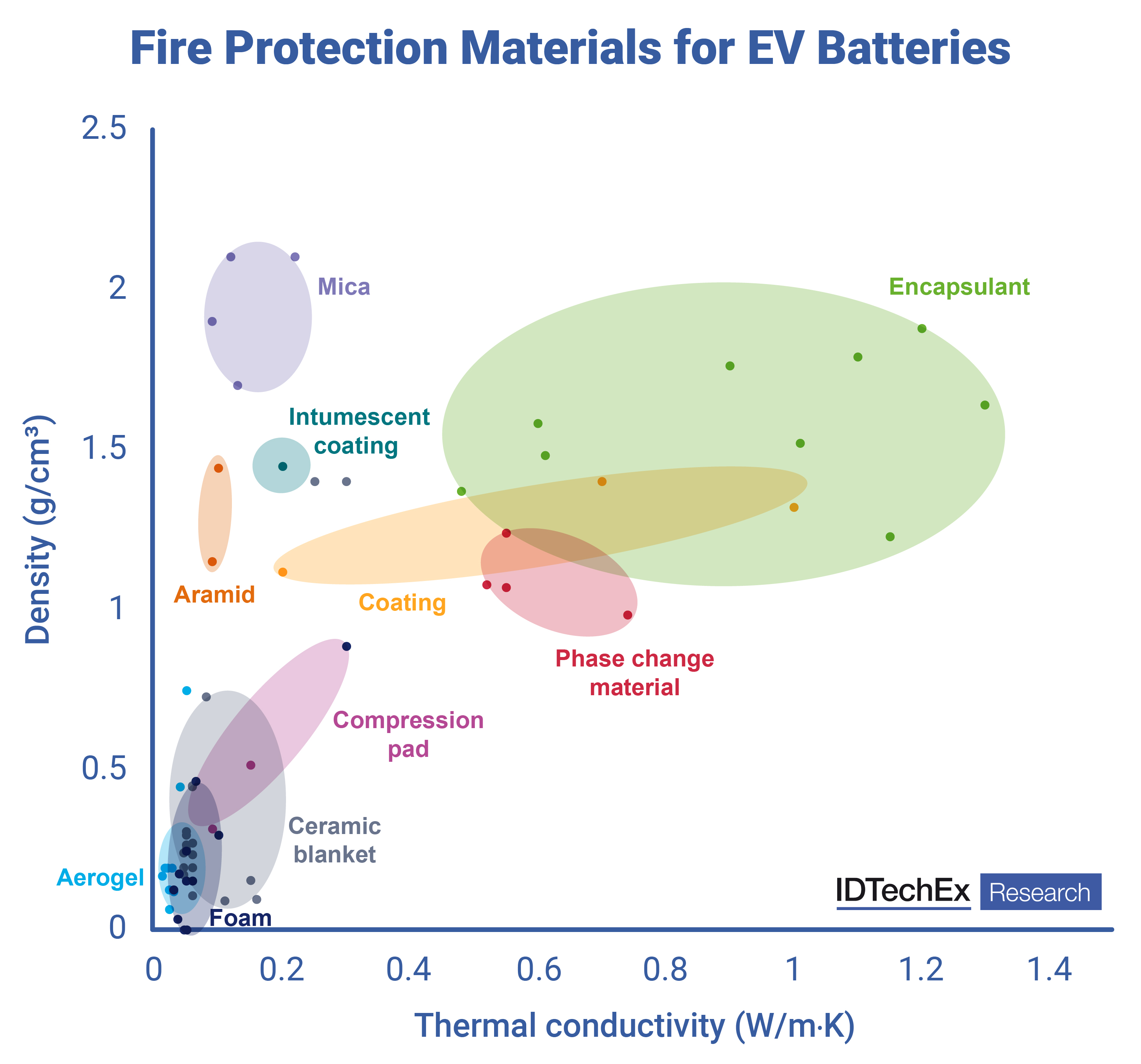
Chinese brands join Canopy
Options assessed for minimising the risk of thermal runaway.

21st February 2024
Innovation in Textiles
|
Boston, MA, USA
A new report from IDTechEx benchmarks the fire protection materials being applied within electric vehicle (EV) battery packs, including ceramic blankets, sheets and other nonwovens, mica, aerogels, intumescents and other coatings, encapsulants, encapsulating foams, compression pads and phase change materials.
“EV fire safety continues to be a critical topic, although data continues to support the fact that they are less likely to catch fire than internal combustion engine vehicles,” says IDTechEx research director Dr James Edmondson. “However, as a new technology, EVs get more attention and even a very low occurrence rate still poses significant risks to vehicle occupants and surroundings.”
It is also unclear what the impact of ageing vehicles on the risk of thermal runaway will be, he adds. Effective thermal management, quality control and battery management systems minimise the risk of thermal runaway occurring, but fire protection materials are the primary method of either preventing its propagation or delaying its progression long enough to meet regulations and provide safety for occupants.
IDTechEx predicts the EV market will be worth $3.5 trillion by 2044 and with so many vehicles in operation, safety will be paramount.
Battery design evolution
Various cell formats and battery structures are used in the EV market. According to IDTechEx, in 2022, 55% of new electric cars sold used prismatic battery cells, with pouch cells accounting for 24% and the rest using cylindrical cells. Each has different needs in terms of inter-cell materials, which has driven the trends in fire protection material adoption. Cylindrical systems have largely used encapsulating foams, for example, whereas prismatic systems typically use materials in sheet format.
Many manufacturers are also moving towards a cell-to-pack design where module housings and a host of other materials are removed, leading to improved energy density but potentially more challenging thermal runaway propagation prevention. These design choices all greatly impact the selection and deployment of fire protection materials.
Properties
Thermal conductivity, density, thickness, dielectric strength and maximum fire protection temperature are the key properties determining the optimal fire protection material. Each of these is important in isolation but must be considered at a pack level – and naturally not forgetting cost. A material can be very lightweight, but if a large amount is required in order to provide protection, then it may not be the best solution. Likewise, if a material has to be paired with others to provide all the necessary functions, then it may impact its performance and cost-effectiveness.
As an example, an aerogel blanket used for pack-level protection would be approximately 25% lighter than the equivalent mica sheet. For cell-level protection, mica and aerogels can have a similar weight per kWh of battery, but other considerations should be made for compression performance and thickness, which will impact volumetric energy density.
Options
Ceramic blankets have been a common choice to provide protection above the cells and below the lid and to delay the propagation of fire outside the pack. Mica sheets are another popular choice with excellent dielectric performance at thin thicknesses between cells, but are often used in thicker sheets above modules.
Aerogels are continuing to see market progress, with significant adoption in China, but also now globally through adoption by OEMs including Audi, GM and Toyota.

The use of encapsulating foams has also seen significant adoption in cylindrical cell battery packs by the likes of Tesla, to provide lightweight thermal insulation and structure. For pouch cells, compression pads are commonplace to accommodate cell swelling and several material suppliers are starting to combine this functionality with fire protection to provide a multifunctional solution.
“There are many material options in addition to the ones already mentioned, and polymer suppliers are making a big push to provide major components of the battery pack with fire-retardant polymers or even polymers with intumescent properties,” says Edmondson. “These have the potential to be lighter, more customizable in geometry and lower cost than metals and fire protection materials combined. However, there are still significant challenges here, such as integrating EMI shielding and providing the necessary crash performance.
Outlook
“The EV market continues its strong growth, and with more vehicles on the road, it is becoming more critical than ever to provide effective protection from thermal runaway,” he concludes. “Regulations are continuing to develop, putting a greater focus on battery safety, leading to greater opportunities for material suppliers. However, as vehicle makers are striving to reduce costs, providing materials that can cater to multiple functions at a reasonable price point is key to their future progress.
The IDTechEx report, Fire Protection Materials for EV Batteries 2024-2034: Markets, Trends, and Forecasts, finds that the EV battery fire protection material market will grow at 16.1% CAGR between 2023 and 2034.
Dr James Edmondson is also presenting a free-to-attend webinar The Evolving Opportunity in EV Battery Fire Protection Materials on Thursday 29 February 2024.
Registration and timing details can be accessed here.

Business intelligence for the fibre, textiles and apparel industries: technologies, innovations, markets, investments, trade policy, sourcing, strategy...
Find out more